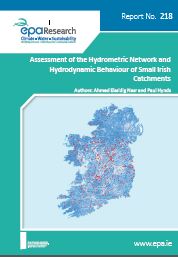Authors: Ahmed Elssidig Nasr and Paul Hynds
Summary: Research Report 218 on the Assessment of the Hydrometric Network and Hydrodynamic Behaviour of Small Irish Catchments

The combined effects of climate change and population growth (anthropogenic pressure) represent a significant challenge with respect to water resource management, both nationally and internationally. Recent flood events, in addition to projected urban water shortages, have brought these issues into sharp focus. Improving our understanding of the hydrodynamics of small Irish river catchments is of paramount importance in addressing a range of water resources management challenges including municipal and commercial water abstractions, flood risk management, and water quality. This desk study sought to develop recommendations relating to hydrometric monitoring requirements for small catchments in Ireland via an integrated mixed methods approach. The study design encompassed (i) a statistical assessment of the current and historical small catchment network, (ii) selection of study catchments, (iii) quantification of the temporal and spatial hydrodynamics of selected small catchments via multiple existing approaches, and (iv) examine current hydrometric data usage, perceived network and data efficacy and limitations, and potential (prioritised) network improvements among users of the Irish hydrometric network.
Results of this research project indicate that network amendments over the past three decades have resulted in a significantly contracted small catchment network.. Hydrological modelling of selected study catchments at both daily and hourly time-steps found that existing models provide low to moderate accuracy, with particularly poor simulation accuracy associated with small upland and urban catchments, irrespective of temporal resolution. This study concludes that significant gaps currently exist with regard to our current ability to predict and manage small catchment hydrodynamics.
The key recommendations from this project are threefold:
Firstly, due to the nature of small catchment associated knowledge and data gaps, development of a small catchment classification system based upon existing hydrometric and physical catchment data is required.
Secondly, “sentinel” catchments from each developed cluster should be identified, based upon cluster membership and the availability of high quality continuous hydrometric data, followed by development of representative hydrological models for each small catchment cluster (type).
Finally, a decision-based tool based upon catchment type and associated hydrodynamic behaviour is required
in order to inform future catchment instrumentation and overarching network amendments.